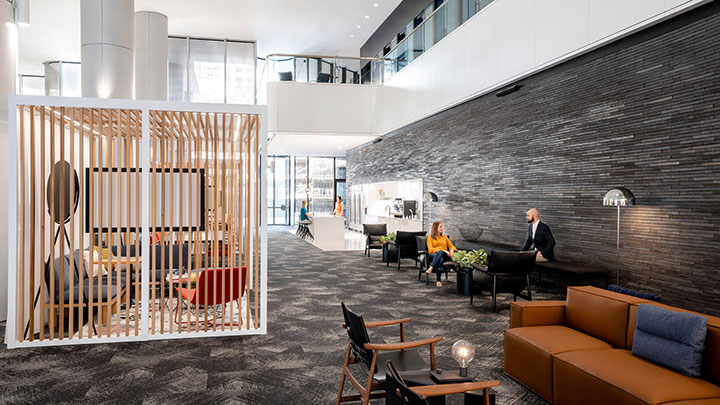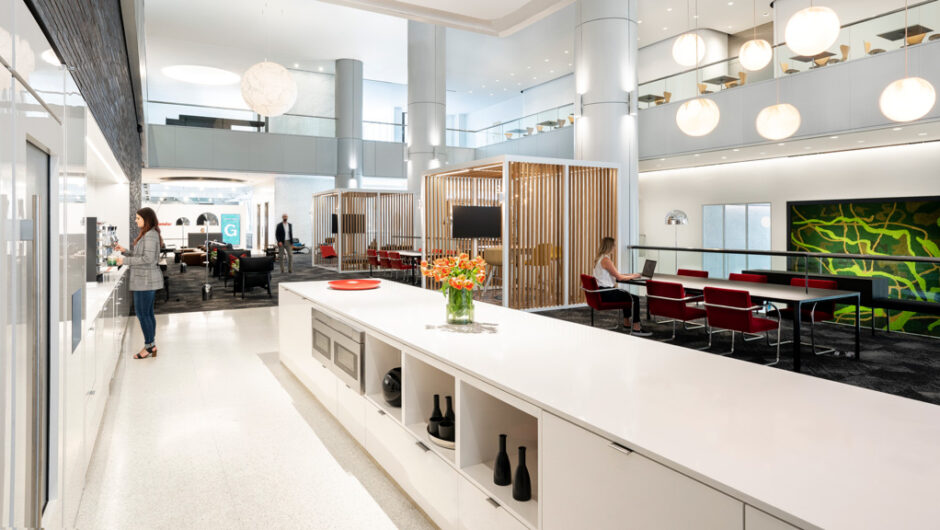Unlike “déjà vu,” a “vuja de” moment is when you feel like you’ve been in the same situation before, but this time it’s completely different. Like when you’re invited to the circus and you’re thinking Ringling Brothers, but upon your arrival, you experience Cirque du Soleil – same idea, but nothing like you expected.
I’m hoping for a “vuja de” experience when we return to the office. It might seem like the office we left in 2020, but because of the new perspective we’ve developed after working from home for over a year, I suspect we’ll be seeing it in a new light. Rather than slipping into old habits where work is mostly done at the workplace, I hope that we will view the office as one of many places that we can work effectively.
I’ve always been an advocate for agile working, with a belief that multiple settings throughout the workplace designed specifically to support the range of tasks at hand is the way to go. Admittedly, some people need dedicated, assigned space for their role. But many of us have found a certain freedom in not being tethered to a desk or an office, roaming freely throughout the day from place to place. Now that employees have experienced remote working, I think they will be more willing to try a more flexible way of working when we return.
At Gensler, we’ve been working from home since March 2020. Initially, I was thinking, “this isn’t so bad.” I could roll out of bed to get on my Teams meetings half-dressed, join virtual happy hours and coffee chats, and take mid-day walks. But as spring turned to summer, then to fall, and now winter, I, like so many of my colleagues, have developed a bad case of “blursday.”
Many didn’t believe remote working was even possible when the pandemic started. A friend of mine said it felt like forced retirement. Nine months later, Gensler’s Work From Home survey results found 19% of respondents would prefer working full time at home, 29% full time at the office and 52% would prefer some combination of the two, or what we’ve coined a “hybrid work model.”
Beyond my own early findings, there are other benefits found in Gensler’s survey results about working from home: comfortable working conditions, saving time and money, no commute, and for many, higher productivity. At the other end of the spectrum, those working full time at the office also reported higher productivity, better technology and workspace set-up, and more access/visibility to colleagues.
I find it interesting that those working full time at home and those working full time at the office both reported higher productivity, and I suspect it depends on the work they’re doing most of the time, the industry, and their role. People working full time at the office spend twice as much time collaborating compared to those full time at home (52% vs 27%). Conversely, people working full time at home spend significantly more time in a focused work mode than those full time in the office (62% vs 39%). Those with the ability to choose a hybrid approach see the benefit of a more balanced focus/collaboration work setting with equal amounts of their time spent on heads-down work and collaborating with others (44% each for those working one or two days per week at home).
Some might suggest the office should be re-designed for collaborating and socializing and rely more heavily on the home or a third place for focus work. Time at the office could be scheduled or reserved for anticipated meetings and social events, while the rest of the time could be spent more effectively working from home. But in my experience, work is more fluid with individuals bouncing throughout the day between focused work, collaborating formally or informally, socializing, and learning. Other than for those regularly held meetings, the notion of scheduling where to work based on work mode seems too structured for the way work naturally happens throughout the day.

I keep returning to the hybrid work model as the best approach for most individuals and teams in our knowledge sharing world. The respondents to Gensler’s survey working in a hybrid model reported higher personal creativity and problem solving and better team relationships than those working full time at home or at the office.
So, what should the office of the future be like?
- Knowing that creativity, innovation, collaboration, socializing, and culture are the attributes that should be emphasized, future offices should obviously provide an abundance of meeting rooms for small and large groups – of course with built in, intuitive technologies to access remote attendees.
- Casual meeting and lounge spaces with a variety of flexible ancillary furniture and lighting options should be available — some semi-enclosed, but mostly open.
- Central to the collaboration areas should be a cafe with high quality food and beverage offerings throughout the day for employees and guests.
- Even though focused work may be secondary to other work modes, there should still be enclosed, individual spaces for heads-down work, as well as portable screens that employees can use to create a semblance of privacy in an open setting.
- A nearby library or resource center should be available with tech support.
- There should be great wi-fi access for all throughout the space along with other ubiquitous A/V points.
- Access to outdoor spaces — or at least expansive views to the outside — would be beneficial.
- And finally, the overall space should express the company brand values.
Given the fact that significantly fewer employees will be coming to the office everyday with this new flexible, hybrid work approach, the office won’t need to be nearly as large as it once was. With landlords offering more valued amenities such as conferencing, fitness, food & beverage, and coworking areas, the tenant workspace is expanding beyond the lease lines. Those with long commutes might want to schedule meetings and social activities at the office on certain days, while those with only a short drive or within walking/biking distance can come in as needed throughout the day. Regardless of the commute, this will be an office where employees will want to go, even if they don’t have to.
Imagine returning to a workplace as a choice, on your own schedule. And when you leave you feel more energized than when you arrived. That would be a “vuja de” day.
Editor’s note: this article originally appeared on gensler.com


